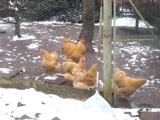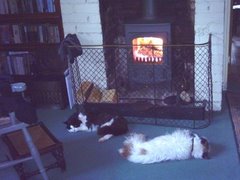Rooks or crows? Now there's a question I've never got round to answering. I grew up in Bournville, Birmingham, and used to love to listen to the nightly raucous pilgrimage of said birds as they returned to roost at night. As a child, it was a daily marking of time; getting ready for bed and the onset of darkness.
It's correct name is Bournville Village, designed and built by the Cadbury family for their workers at the chocolate factory in 1893. The estate was called Bournville after the nearby Bourn Brook and the French word “ville” for town. Originally, the estate consisted of a scattering of farmsteads and cottages, linked by winding country lanes, set in a rural area (then) to the south of Birmingham. The Cadbury brothers chose this area for their factory as it was regarded as being cleaner and healthier and gave ample room for expansion, as well as already having a railway station and canal.
The Cadbury family were Quakers and held their workers in high respect, providing homes in the village, with gardens large enough for fruit trees and vegetable patches. To this day, the gardens are considerably large and, although some are still rented from the Bournville Village Trust, many are now in private ownership. This was not the full extent of the Cadbury generosity: they paid high wages, pioneered pension schemes, joint works committees and offered a full staff medical service. They even provided holidays for the under-privileged in Cadbury owned holiday homes.
By the year 1900, the estate included 313 cottages and houses on 330 acres of land, and many more similar properties were built in the years leading up to the first world war. Bournville became a blueprint for many other model village estates around Britain. However, as George Cadbury was a Quaker, no public houses have ever been built in Bournville, although since the late 1940s there has been a licensed members' bar at Rowheath Pavilion.
The Cadbury concern for the health and fitness of their workforce, meant that park and recreation areas were key in the Bournville village plans. In the early 1920s, extensive open lands were purchased at Rowheath creating football and hockey pitches, as well as a grassed running track. George Cadbury designed the Rowheath Pavilion and it was built in accordance with his instructions, opening in July 1924. It served as the clubhouse and changing rooms for the sports playing fields, several bowling greens, fishing lake and an outdoor swimming Lido, a natural mineral spring forming the source for the lido's healthy waters. The Rowheath Pavilion itself, which still exists, was used for balls and dinners, and the whole area was free of charge to use by the Cadbury workers and their families. The lido was eventually closed in the 1970s after complaints of noise disturbance were made by residents of the newly built Oak Farm estate, coupled with new health and safety regulations. Cadbury's also built an indoor swimming baths on Bournville Lane, the Valley Pool boating lake and the picturesque cricket pitch next to the factory site, that was made famous as the picture on boxes of Milk Tray chocolates throughout the 1950s and 1960s.
The Bournville Village Trust was set up in 1900 to formally control the development of the estate, independently of George Cadbury, or the Cadbury company. It is a conservation area and, as such, there are strict guidelines for extension and modification of properties. A true village feel evolved, with a triangular village green, infant and junior schools, the School of Art and the Day Continuation School (originally intended for young Cadbury employees) plus a host of events such as fêtes and dances are held. The carillon on top of the junior school and a Quaker meeting house are also beside the village green.

I went to both the infant and junior schools, attended Sunday School at St. Francis church, and used to run down the hill on Saturday mornings, when the carillon bells rang out for weddings, arriving breathlessly to see the bride and groom emerging from the church. Such warm and happy memories of a wonderful childhood spent in idyllic surroundings.
We lived in Acacia Road – all the roads were originally named after trees: there's Sycamore Road, Maple Road, Hawthorn Road, Mulberry Road........... Home was a 3 bedroomed, end of terrace cottage, with a Park-Ray coal fire in the kitchen and the ubiquitous “Sheila maid” airing rack, with pulley, above. There was an apple tree in the garden with the most amazing blossom and this was my den, high up amongst the branches, peeping at the world through the leaves. I had a sand pit, swing and gold fish pond, watched over by models of Snow White and the Seven Dwarfs (hand painted by me!). I loved to help on wash day and used to wait on the other side of the electric mangle to catch the clothes as they came through the other side. My room was a tiny single room overlooking the back garden – I still remember the floral wallpaper, the chest of drawers, single wardrobe and simple wooden chair with a rush seat. There was nothing more in the world I could have wished for and today my home has echoes of my memories, keeping those treasured times close.
Bournville has, of course, changed much since then, but the bones are still there. It has grown – it now contains over 7,500 homes on 1,000 acres of land, alongside 100 acres of parks and open spaces. It remains a popular residential area of Birmingham but I have moved on and my home is now well and truly in the countryside.
However, I still go to the dentist there and always get a familiar rush of warmth as I catch glimpses of “old Bournville”. The surgery is opposite the woods, which are full of bluebells in the Spring, and from the waiting room, I can see the path I used to skip along and my “secret” fairy tree. The last time I went, I ambled across, furtively looking over my shoulder to make sure no-one was watching. As I approached the tree, it was hard to see the little wishing well type hole in the trunk that I used to put a half pence piece in and make a wish to the fairies. But it was there; covered over with ivy and so obviously unknown to anyone else in the whole wide world. My secret place. I felt both glad and sad – glad that it was still mine, but then swiftly followed by sadness that no other little girl could feel the magic of the fairy tree. Cautiously, I prodded my finger into the hole – the adult in me squirming at what beasties might be lurking in the little pool of water. It was empty. No half pence pieces – the fairies must have taken them...........
It's those birds, though. Each evening I hear the same raucous noise as they head into the wood in the corner of the field at the bottom of my garden; a mob of black birds silhouetted against the darkening sky as they fly to the trees to roost. I picture my fairy tree in Bournville, just for a fleeting moment, standing at the edge of those far away woods, knowing the same noise is going on there, as it has for years and years. A noise so familiar from childhood through to the present day, and yet I still haven't decided if they are rooks or crows! Any suggestions gratefully appreciated!!






